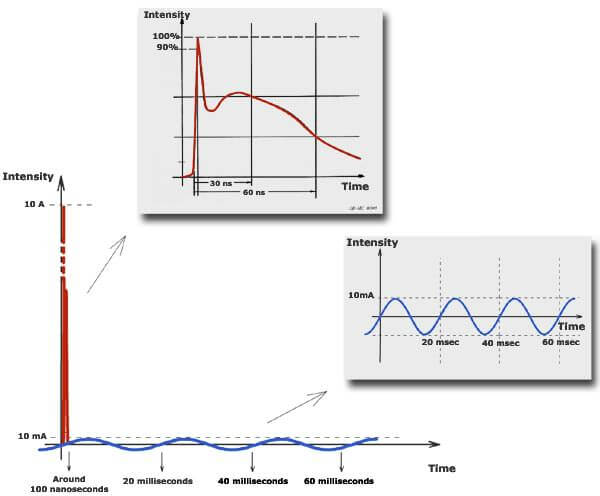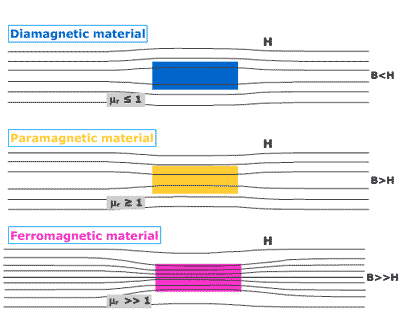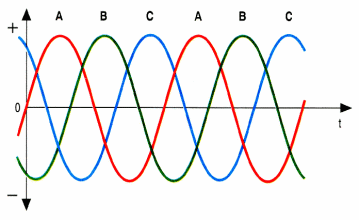It is a weak current that leaks from the network and flows out of the electrical installation, assuming no actual “fault”. It is not incompatible with the apparently normal operation of electrical devices. It sometimes increases over time because of the progressive deterioration of the insulation. (see “In more technical detail”).
The leakage exists because a connection through a very high impedance, though not infinite, exists between the live conductors in a circuit and the other conducting parts of the appliance (metallic frame, etc.). For a current to exist, the circuit must be somehow closed, this can happen in several ways:
- If this “connection” impedance is very high, say more than a few tens of MΩ (megohms) in our 230 V residential installation, the earth current will be very small. For example, for an impedance of 2.3 MΩ between live conductors and the other conducting parts, the current will be 100 microamperes of leakage.
- When the impedance is not quite as high, the conducting parts of the appliance (such as the metallic frame) are at a non negligible potential. The earth current may become sizeable, say a few mA. In order to avoid this problem, building regulations require that appliances be earthed (metallic frames, enclosures, etc.). That way, the frame is practically at earth potential, since the earth conductor impedance is typically only between 10 to 20 ohms. If the impedance of the insulation fault is still high (otherwise, you’d get a short circuit), the earth current will just drain through the earth conductor. The exact potential of the appliance frame can be calculated as the earth current, say 10 mA multiplied by the impedance of the earth conductor, say 10 Ω, is a potential of 100 mV. Note that in order to have a 10 mA earth current, the impedance due to the insulation deterioration would have to be 23 kΩ. This is very rare in a correctly isolated installation, but it can also happen because of the presence of anti-interference filters (capacitors between live conductors and the frame).Without earthing, the frame would be at a potential different from that of earth, waiting for the unhappy soul who will make the connection with earth. This would be dangerous as earthing will take place through that person who will be electrocuted by the current (contact current this time).
Note: An earth leakage of 10 mA for example doesn’t mean that the contact current would be 10 mA because in that case, the current will depend on the additional impedance of the body, the contact points (hand-frame or feet-floor), and of the return circuit through the ground.
Earth leakage currents have the same frequency as the underlying current. Thus we can assume that it is alternating at 50 Hz (in Europe), that is with a 20 ms period, except that harmonics are almost always present (predominantly 5, 7, and 11 times 50 Hz) but with much lower amplitudes.
As we just saw, earth leakage currents present a danger for people safety.
An RCD does protect against earth leakage as it will trip whenever the difference between phase and neutral exceeds a predetermined value. Typically, the limit is 300 mA for complete installations and 30 mA in bathrooms (note that only 30 mA RCDs protect people; 300 mA protects mostly against thermal overloads and the risk of fire).
Earth leakage currents present practically no risk of fire.
Fuses and circuit breakers do not react to leakage current.
In more technical detail …
Earth leakage current path impedance has two components: resistive and capacitive:
- The capacitive component exists continuously as it is due to the fact that some of the alternating current escapes the wires, even in perfect condition, by capacitive effect; but it leads to only a few tens microamperes for a complete residential installation.
- The resistive component is due to the partial degradation of the wires insulation (when the degradation is total, it creates a short-circuit and a fault current). The partial degradation reduces the impedance to a non-infinite value between the wire itself and the outside. This is where the current “leak” out of the network occurs.
This leakage current must be both channelled and limited in amplitude. Channelled to prevent metallic parts of a device from acquiring a potential; earthing takes care of that. Limited for two reasons: (i) in case where metallic parts acquire a potential other than earth (earth fault), its amplitude is harmless and (ii) avoid having a resulting current capable of electrocuting someone.






